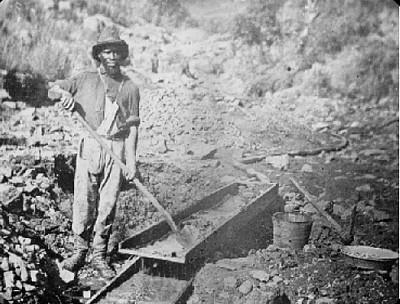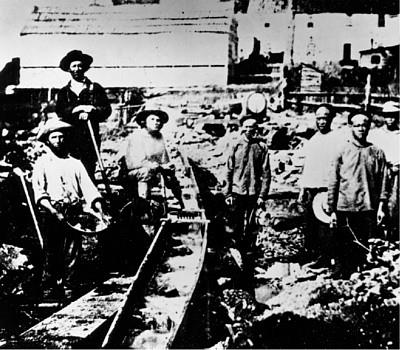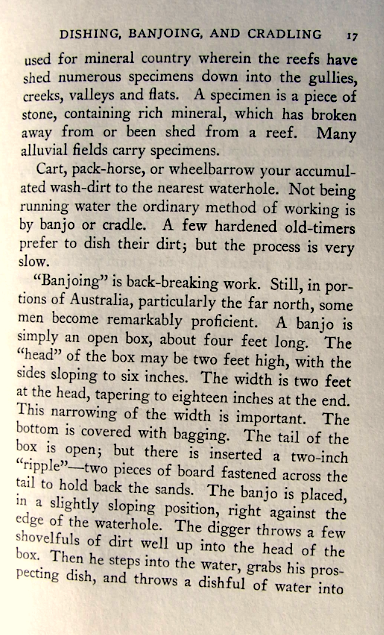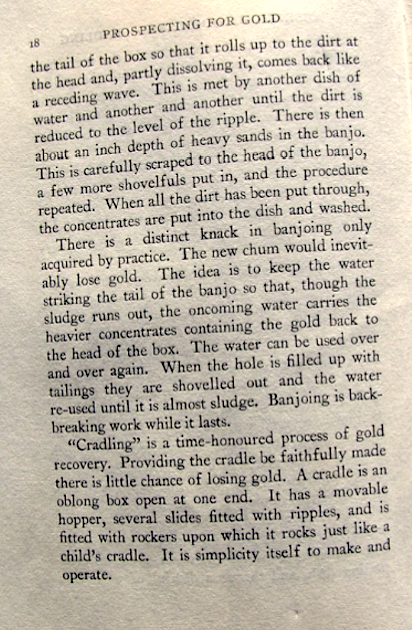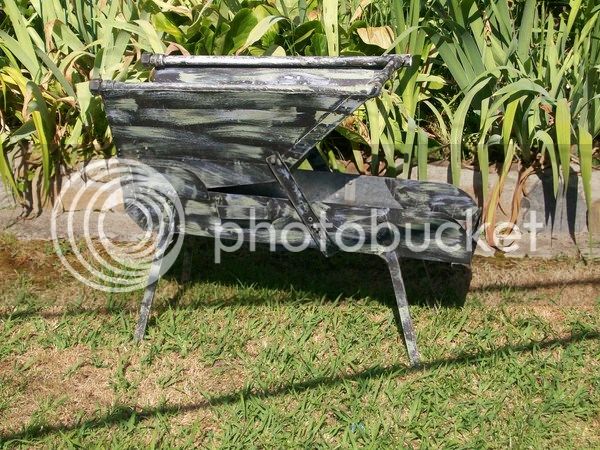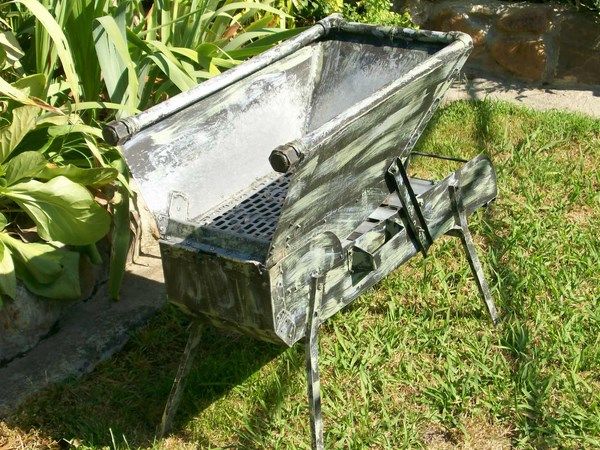G
Guest
I found this bit of gear interesting. Thought you might do as well. Jembaicumbene
Dip-Box
The dip-box is useful where water is scarce and where an ordinary sluice cannot be used because of the terrain. It is portable and will handle about the same quantity of material as the rocker.
Construction is relatively simple. The box has a bottom of 1- by 12-inch lumber to which are nailed 1- by 6-inch sides and an end that serves as the back or head. At the other end is nailed a piece approximately 1 inch high. The bottom of the box is covered with burlap, canvas, or thin carpet to catch the gold, and over this, beginning 1 foot below the back end of the box, is laid a 1- by 3-foot strip of heavy wire screen of about 1/4-inch mesh. The fabric and screen are held in place by cleats along the sides of the box. Overall length may be 6 to 8 feet, although nearly all gold will probably collect in the first 3 feet. The box is placed so the back is about waist high; the other end is 1/2 to 1 foot lower. Material is simply dumped or shovelled into the upper end and washed by pouring water over it from a dipper, bucket, hose, or pipe until it passes through the box. The water should not be poured so hard that it washes the gold away. Larger stones (after being washed) are thrown out by hand, or a screen-box can be added to separate them. Riffles may be added to the lower section of the box if it is believed gold is being lost.
Taken from
http://www.minelinks.com/alluvial/dipbox.html
Dip-Box
The dip-box is useful where water is sparse, the ground is too flat for a sluice box, ordinary sluice cannot be used or you can't get hold of a rocker. It is portable and will handle about the same quantity of material as the rocker. A dip box is simply a short sluice that is mounted on legs and depending upon the individual can be about waist high. A screen is placed over the head of the dip-box to handed the classifying and sorting of the tailings, dirt, clay, sand, or gravel. The slope depends on the height of the front legs and the hind legs. Gravel added and a bucket or what ever is on hand is used to add the water and wash the gravel down the dip-box. The material runs down the dip-box slope concentrating the gold inside the box.
Dip Box Construction:
Bottom and side lumber about 6 to 8 feet long.
Bottom a 1- by 12-inch lumber to which are nailed 1- by 6-inch sides
Either end will serve as the back or head.
At one end is nailed a piece lumber approximately 1 inch high.
The bottom of the box is covered with burlap, canvas, or thin carpet to catch the gold, and over this.
Riffles - Beginning 1 foot below the back end of the box is a 1- by 3-foot strip of heavy wire screen of about 1/4-inch mesh. This is a easy way to make the riffles by placing a sheet of wire mesh on the bottom five feet of the burlap or carpeted channel.
The fabric and screen are held in place by cleats along the sides of the box. While the overall length may be 6 to 8 feet, nearly all gold will probably collect in the first 3 feet.
The box is placed so the back is about waist high; the other end is 1/2 to 1 foot lower.
Gravel is added into the upper end and washed down by pouring water over it from a dipper, bucket, hose, or pipe until it passes through the box. The water will then wash the gravel over the top of the riffles but take care not to pour so hard that the gold gets washed away.
Larger stones (after being washed) are thrown out by hand, or a screen-box can be added to separate them.
Riffles may be added to the lower section of the box if it is believed gold is being lost.
Taken from
http://www.nuggetshooter.ipbhost.com/index.php?showtopic=27443
Dip-Box
The dip-box is useful where water is scarce and where an ordinary sluice cannot be used because of the terrain. It is portable and will handle about the same quantity of material as the rocker.
Construction is relatively simple. The box has a bottom of 1- by 12-inch lumber to which are nailed 1- by 6-inch sides and an end that serves as the back or head. At the other end is nailed a piece approximately 1 inch high. The bottom of the box is covered with burlap, canvas, or thin carpet to catch the gold, and over this, beginning 1 foot below the back end of the box, is laid a 1- by 3-foot strip of heavy wire screen of about 1/4-inch mesh. The fabric and screen are held in place by cleats along the sides of the box. Overall length may be 6 to 8 feet, although nearly all gold will probably collect in the first 3 feet. The box is placed so the back is about waist high; the other end is 1/2 to 1 foot lower. Material is simply dumped or shovelled into the upper end and washed by pouring water over it from a dipper, bucket, hose, or pipe until it passes through the box. The water should not be poured so hard that it washes the gold away. Larger stones (after being washed) are thrown out by hand, or a screen-box can be added to separate them. Riffles may be added to the lower section of the box if it is believed gold is being lost.
Taken from
http://www.minelinks.com/alluvial/dipbox.html
Dip-Box
The dip-box is useful where water is sparse, the ground is too flat for a sluice box, ordinary sluice cannot be used or you can't get hold of a rocker. It is portable and will handle about the same quantity of material as the rocker. A dip box is simply a short sluice that is mounted on legs and depending upon the individual can be about waist high. A screen is placed over the head of the dip-box to handed the classifying and sorting of the tailings, dirt, clay, sand, or gravel. The slope depends on the height of the front legs and the hind legs. Gravel added and a bucket or what ever is on hand is used to add the water and wash the gravel down the dip-box. The material runs down the dip-box slope concentrating the gold inside the box.
Dip Box Construction:
Bottom and side lumber about 6 to 8 feet long.
Bottom a 1- by 12-inch lumber to which are nailed 1- by 6-inch sides
Either end will serve as the back or head.
At one end is nailed a piece lumber approximately 1 inch high.
The bottom of the box is covered with burlap, canvas, or thin carpet to catch the gold, and over this.
Riffles - Beginning 1 foot below the back end of the box is a 1- by 3-foot strip of heavy wire screen of about 1/4-inch mesh. This is a easy way to make the riffles by placing a sheet of wire mesh on the bottom five feet of the burlap or carpeted channel.
The fabric and screen are held in place by cleats along the sides of the box. While the overall length may be 6 to 8 feet, nearly all gold will probably collect in the first 3 feet.
The box is placed so the back is about waist high; the other end is 1/2 to 1 foot lower.
Gravel is added into the upper end and washed down by pouring water over it from a dipper, bucket, hose, or pipe until it passes through the box. The water will then wash the gravel over the top of the riffles but take care not to pour so hard that the gold gets washed away.
Larger stones (after being washed) are thrown out by hand, or a screen-box can be added to separate them.
Riffles may be added to the lower section of the box if it is believed gold is being lost.
Taken from
http://www.nuggetshooter.ipbhost.com/index.php?showtopic=27443




